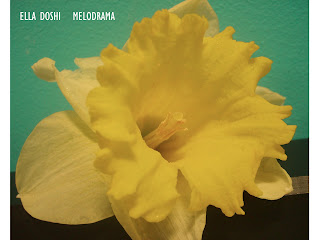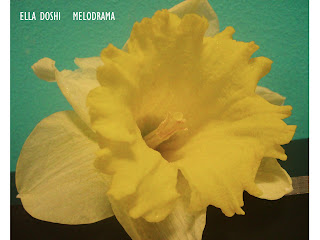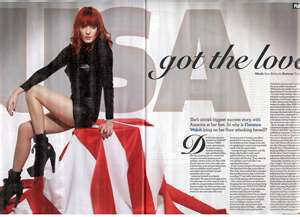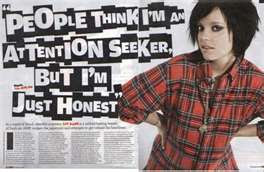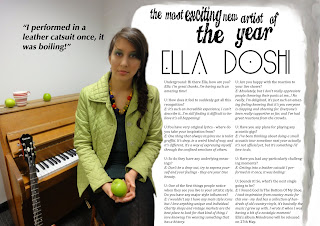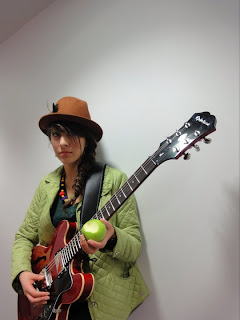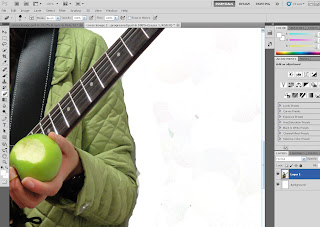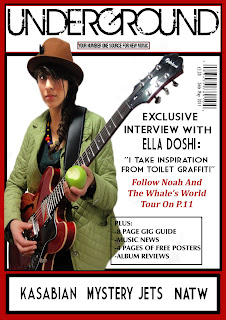Here is the extended interview. Before writing it I did more research into existing interviews in music magazines such as NME; the prominent casual tone that I found in nearly all of them is something I have tried to emulate as much as possible in my own interview, whilst trying to get across the singer's personality. The introductory paragraph at the beginning was something I thought of when noticing that all of the interviews I was looking at for research included some form of introduction, whether it be meeting the band or information about the artist. Most of the ones I looked at in NME were extremlely casual and tended to be about meeting the band or artist and, at times, describing their mood, so it was this type of introduction that I decided to write:
Talking to Ella Doshi is like a breath of fresh air to my day; after simply exchanging hellos and pleasantries, I have almost forgotten my splitting headache, or the fact that I will soon have to sit on the cramped, sweaty tube for an hour and a half to get home. The singer seems to radiate hyperactivity and happiness, which is almost catching. Perched on a precarious-looking bar stool, she chats away as though she has known me for years, something which is incredibly refreshing for an interviewer like me who has gone through countless painful interviews with fame-sick singers who remain uninterested and subject to much ‘editing-through-artistic-licence’.
Underground: Hi there Ella, how are you?
Ella: I’m great thanks; I’m having such an amazing time!
U: How does it feel to suddenly have all this recognition?
E: It’s such an incredible experience, I can’t describe it…I’m still finding it difficult to believe it’s all happening!
U: You have very original lyrics – where do you take your inspiration from?
E: One thing that always inspires me is toilet graffiti. It can be deep, in a weird kind of way, and it’s different – a way of expressing yourself through the confined emotions of others.
U: So do they have any underlying meanings?
E: Don’t be a drop-out, try to express yourself and what you’re feeling and you could make something really beautiful.
U: A lot of your songs are named after flowers. What’s behind that? E: It’s basically because of my grandad’s garden, which is where I spent most of my time when I was writing the album. I just loved the feeling of being so surrounded by nature, so I named my songs after each of the flowers that he’d planted because I was there for so long that now each flower represents all of the different emotions running through my songs.
U: One of the first things people notice about you live is your artistic style. Do you have any major style influences?
E: I wouldn’t say I have any major style icons but I love anything unique and individual. Charity shops and vintage markets are the best places for that sort of thing. I love knowing I’m wearing something that has a history.
U: If you could meet any three people who would they be?
E: Probably Noel Gallagher, Johnny Depp and Jamie Oliver.
U: Is there any musician you would like to collaborate with?
E: I’d absolutely love to do something with Mumford & Sons, I’m a massive fan of theirs and I’m just so inspired by their music.
U: Are you happy with the reaction to your live shows?
E: Absolutely, but I don’t really appreciate people throwing their pants at me…! No really, I’m delighted, it’s just such an amazing feeling knowing it’s you people are clapping and cheering for. Everyone’s been really supportive so far and I’ve had a great reaction from the crowds.
U: How do you feel about winning best new artist of 2011?
E: I’m over the moon, it was just so unexpected! I’m just so grateful for all the support my fans have given me, I couldn’t have got here without them.
U: Have you any plans for any acoustic gigs?
E: I’ve been thinking about doing a small acoustic tour sometime next year actually, it’s not official yet but, it’s something I’d love to do.
U: Have you had any particularly challenging moments?
E: Getting into a leather catsuit! I performed in it once, it was boiling!
U: Sounds it! So, what’s the next single going to be?
E: I Found Love In The Bottom Of My Shoe. I took inspiration from country music for this one – my dad has a collection of hundreds of old country vinyls, it’s basically the music I grew up listening to.
U: If you could spend the evening with three musicians, dead or alive, who would they be?
E: Laura Marling, Johnny Cash and David Bowie. I’ve met Laura before she’s so down to earth and we just get on so well, but she also makes such beautiful music and I incredibly admire the originality of her lyrics – she’s an inspiration. Johnny Cash is obviously due to my recent fetish with country music, plus I think he’s an absolute legend with a fascinating background.
U: And David Bowie...?
E: Haha! I was trying to avoid this, but I’m just completely obsessed with him! I used to be in an electro-rock band when I was about 15, I even dressed like him which is pretty embarrassing looking back…
U: Yes, um, I’m, trying to picture that image… I’ve forgotten what my next question was now.
E: Sorry…
U: Never mind. Ever thought of making a Bowie tribute album then?
E: Haha well I think I’ll have to now!
U: Well good luck with that! I’ve remembered what my next question was now. Would you like to hear it?
E: Go for it!
U: What are your opinions on all the music downloading and file sharing that’s going on? Are you for it or completely against it?
E: I wouldn’t say I was against it exactly, because sites like Limewire can really help launch an unsigned artist’s career, but then at the same time they can really damage it. Speaking from my own experiences, I know that if people hadn’t been buying my E.Ps I would have been dropped from my record company, you know, I wouldn’t even be here right now, being interviewed. I’m not going to act like we don’t all do it, because I do from time to time, and it just is more practical sometimes, but I think a healthy balance of file sharing and actually buying music off iTunes or as an album wouldn’t go amiss for some people. It’s a common mistake for people to think that just because an artist is in the music industry and has a record deal they’re making loads of money – it’s just not true for the vast majority. And I don’t know about anyone else, but I would rather have an actual album up on my shelf that just a bunch of files on a computer. It’s more sentimental.
U: Is there anything that’s really annoying you right now that you’d like to get off your chest?
E: Yes! My backing singers keep raiding my fridge. The other day they stole a whole Camembert!
U: Dear me.
E: I was pretty distraught!
U: I can imagine. Well, thank you Ella, it’s been a pleasure. Any last words?
E: Where’s the nearest McDonalds? I’m starving.
Ella’s debut album Melodrama will be released on 27th May with Rough Trade.
You can pre-order now on www.roughtrade.com/elladoshimelodrama





